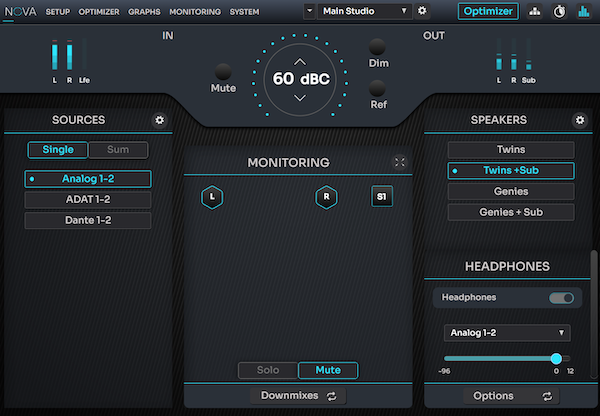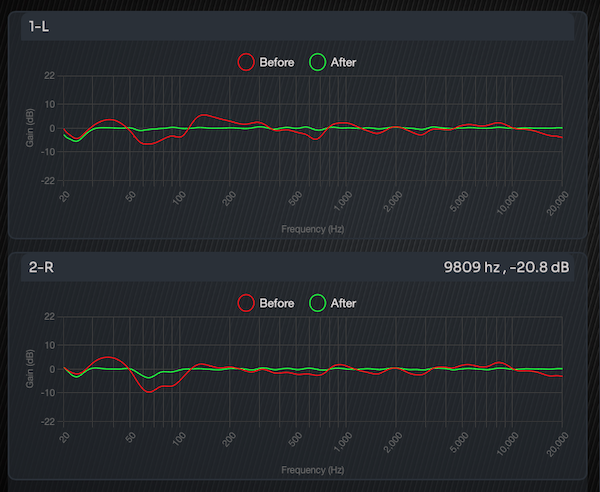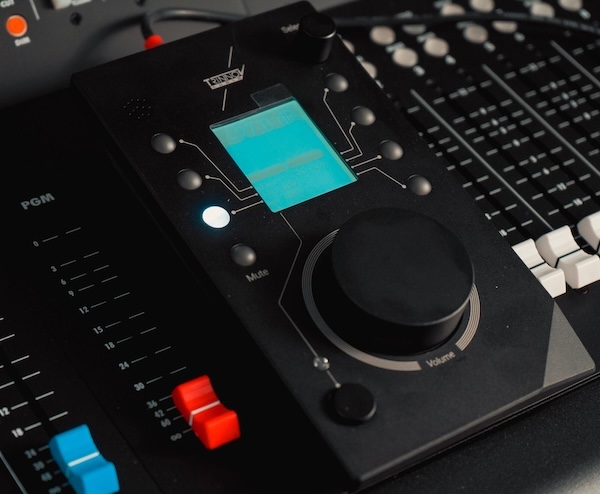 |
|
Looking From The Front At The Internal Chassis of The Trinnov Audio Nova |
Trinnov Application
The Trinnov Application operates as an ethernet bridge using one of two RJ45 connectors on the rear panel. Dante-compatible, this App provides control and interfacing and acts like a switch for access to other Dante devices on your 1GB network as well as the Internet. For control using your iPhone or iPad, there is a free app available with some basic functions including volume, mute, and preset selection.
The Nova is a network device but there is no need know much about networking since it uses Bonjour auto-connect using the same subnet as your computer--it is as "plug n' play" as possible. I took the suggestion from a Trinnov techs to avoid switches, subnets, other potential configuration conflicts by using an inexpensive 1GB USB C-to-ethernet Adapter to connect Nova to your USB hub or directly to your computer.
Compact And Powerful Hardware
The Nova comes with six analog XLR balanced outputs connectors, two XLR analog inputs and four additional TRS analog inputs. You can avoid an A/D conversion by using the ADAT/Light pipe or S/PDIF digital input; however, I didn't notice any difference between digital and analog in the monitor path.
The clean, front panel has an etherCON ethernet port for connecting the measurement microphone using the included and super-long Cat-6e cable. There is a headphone jack with its own specific DAC connected before optimization. The app has buttons for source select as well as a new feature for auto-muting the main monitors while wearing the headphones.
There is a front panel USB jack for the La Remote. It has eight programmable buttons that can be assigned to switch between stored presets, mute, optimization on/off, and a volume control for both your mains and headphones. It also has a large easy-to-read level meter. I used the volume control on my Cranesong Avocet IIA monitor controller and kept La Remote at 0dB for maximum headroom. The back panel EQs on my Focal Trio6 ST6 were set to flat.
 |
Trinnova Screen/GUI
 |
Trinnov Curve and Correction Screen
 |
|
Trinnov La Remote
|
Software And Control
The software, meanwhile, has an organized collection of pages starting with the Home, which shows the Nova logo. If you get lost in a submenu, just click on the logo. The GUI's top menu bar has five subpages: Setup, Optimizer, Graphs, Monitoring, and System.
The Setup subpage is divided into Configuration and Calibration Wizard pages. Optimizer shows a three-sided chart depicting the three different types of optimizations/corrections taking place. There is Acoustic Correction including amplitude and phase, Delay, or time alignment for each speaker relative to the listening position, as Level matching of every speaker. The Optimizer subpage has controls for channels, bass management (I set it to 50Hz 24dB/octave), spatialization, and Bypass mode disables the Optimizer for uncorrected playback.
The Graphs menu shows "before and after" comparisons of the currently running 20Hz to 20kHz measurement/correction for all outputs including the subwoofer(s). The Monitoring subpage has settings for downmixes, headphones, direct outs, and the La Remote configuration and preferences. Lastly, the System menu is a housekeeping page with startup preferences, a latency monitoring choice, a preset library, and hardware (CPU) monitoring.
With this system, it is comforting for me to know that the software is constantly being improved with updates sent directly to the units worldwide over the Internet. (awesome!) Because each unit has its own unique, IP address, if you request it, a company expert back in France will remotely access your Nova to inspect your measurements and suggest improvements. (Note: Nova was updated during this review to improve its connectivity and I did notice an improvement.)
Measurements and Optimization
 |
|
The etherCON 3D Microphone |
The software's Calibration Wizard takes you through the entire measurement and setup process. The Cat-6e cable carries four channels of audio from the etherCON 3D measurement microphone to Nova. The microphone is phantom-powered and has four omni-directional, small-diaphragm condenser microphones. These are arranged in a tetrahedral array with a frequency response of 10Hz to 24kHz.
In Calibration mode, Nova outputs a Maximum Length Sequence--a pseudorandom binary sequence signal from each speaker individually including the subwoofer. This sounds like pink noise but I did hear short impulses within the noise which I was told allows for computational efficient processing. Your control room must be as quiet as possible while the mic picks up sound bouncing around your room. This vast collection of data points is used by the algorithm to develop a profile of the listening space's acoustics and the loudspeakers playing in it.
Accuracy is key here, with the mic's placement and setup crucial for optimum results. The microphone is placed at the measured head/ear height of the listener while sitting at the listening position in front of, and equidistant from, the left and right monitors. Trinnov optimizes at the mix position only. I used a Leica Dist D5 Digital tape measure and a self-leveling laser to accurately set the physical distances, height, L/R monitor angles and the exact height of my monitor speakers sitting on Sound Anchor ADJ-2 stands. All measurements were within +/- 2mm.
What sets the Trinnov apart from other systems is that it measures and corrects frequency response, phase response, amplitude, group delay and impulse response. It measures and checks the physical location of each speaker in the room and their precise angle as aimed towards the listening position—even in ATMOS rooms with sound coming from many monitor speakers.
Integrating Nova
A studio control/listening room should be an acoustic reference space where accurate sonic judgements and changes can be made with certitude. Being confident when developing a mix or final master is all-important. For me previously, getting mixes to translate and sound acceptable outside of my room was a always a game of second-guessing with laborious listening to mixes in other rooms and on different monitors. Sometimes a mix had to sound unbalanced in my room to sound good outside of it! This is no way to work professionally.
My personal mix room has always been problematic acoustically. I have already installed absorption and diffusor panels and use PSI Audio's Active Velocity Acoustic Absorber C20 active bass traps in the front corners of my room. My mix room measures reasonably flat from the mid-range up to through the high frequencies. But as is the case with small residential rooms with 2.4m ceilings, the problems show up in the bass and low-mid range.
I discovered, through measuring with the Trinnov Nova, I had a deep and wide 12dB dip centered at about 70Hz plus another trough at an octave up at about 140Hz. Both of these nodes were affecting what I was hearing in both the bass and the low mid-range. A 70Hz vertical room mode dip center at 1.37m (4.5-feet) is right at my head height (from the floor) while sitting at the mix position. This is part of the reason for the big boost in the subsonic region below 70Hz
Hook Up
For this review, I used the stereo analog outputs from my Cranesong Avocet IIA plugged into the Nova analog inputs. Nova's sample rate is 48kHz for measurements; and using higher system sample rates reduces latency but uses more CPU. I externally clocked Nova using the S/PDIF signal from one of the Avid Interfaces, which are separately externally clocked from my Cranesong Interstellar Master Clock and A/D converter. Nova's System page GUI indicated 30.9ms of latency.
Only One Caveat
For mastering or mixing work only, this latency is not a problem. But for the lowest possible latency monitoring during tracking and/or overdubbing, you must bypass NOVA's optimization. It is simply physics. The required FIR filtering, adaptive optimization and processing the immense amount of data requires about 30ms of latency. On the Optimizer page you can bypass the software for un-corrected monitoring on the La Remote. An update coming will add direct routing of inputs to outputs without latency. Getting latency down to below 5ms is in the works.
Hearing Much More—Some Good Some Not
Listening using Trinnov's optimization is a revelation. Immediately, I hear more detail with good balances and bad balances noticeably distinct at my listening position. My mixes are smoother in the low mid-range and bass. Doing A/Bs of my curated references—some own mixes and some from others was quite an enlightening experience!
The overall subsonic energy now lies within the mix rather than leaping out and/or disappearing on certain notes. Loose-sounding tubbiness in those frequencies is decreased; the mid-range is tighter and more focused with vocals and guitars clearly defined in their panned positions. Stereo reverbs, delays and room ambiences can be heard more accurately--not necessarily louder, just clearer. These effects, as mixed, are better framed around the center-panned instruments and vocals.
Highly Recommended!
The Trinnov Nova optimizes the acoustics in my room and is relatively easy to set up and use. The improvement is not subtle. I've now heard how much it improves the sound and accuracy of my mix room. I must have one!
